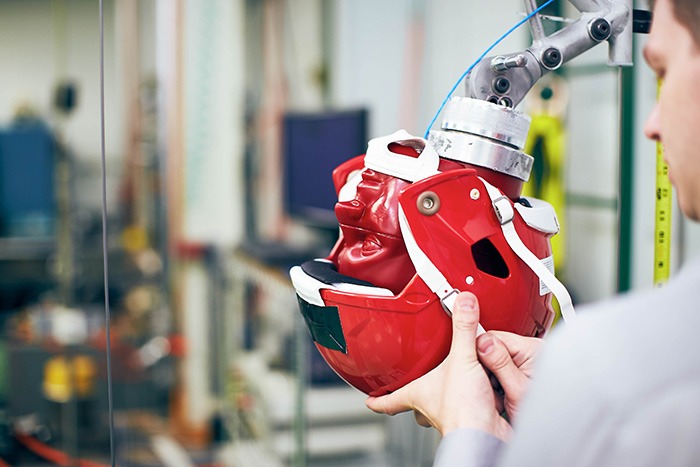ABOUT NOCSAE
Our mission is to commission research, establish standards for athletic equipment and encourage the dissemination of research findings on sport injury and prevention.
Since NOCSAE’s inception in 1970, the organization has been a leading force in the effort to improve athletic equipment and to reduce injuries through robust standards. NOCSAE develops voluntary performance and test standards for athletic equipment. “Voluntary” in this case means our standards are not mandated by a federal agency. But rather, they are enforced by sport governing bodies through rules of play. Numerous national and international regulatory bodies for sports require NOCSAE standards, including the NFL, NCAA, NAIA, National Federation of State High School Associations (NFHS), International Federation of American Football, the United States Polo Association (USPA), USA Football, Pop Warner, USA Lacrosse, Amateur Softball Association, USSSA and USA Baseball as well as the federal DoDEA which oversees and regulates military base athletic programs for the children of military families around the world.
Also see NOCSAE Initiatives.
Meetings
Agenda items for board of director meetings often include discussions of research proposals and funding, budget, and general business and administrative discussions. No standards activity is conducted. Standards activity only occurs during standards committee meetings, which are open to the public.
The NOCSAE Standards Committee serves as a consensus body in accordance with ANSI Due Process requirements for standards development organizations. The makeup of the Standards Committee includes members representing all materially affected interests. Anyone who may be impacted by a standard is encouraged to be involved in its development.
Our Procedures for development and implementation of standards and revisions to existing standards require that a balance of interests is maintained on the Standards Committee. These requirements prevent any single interest from dominating the committee or the development, revision or application of a standard. Brief description of Standards Committee actions.
Research Funding
NOCSAE fosters and encourages the dissemination of research findings on athletic equipment, injury data, and other closely related areas of inquiry in the fields of athletic and sports medicine. Since 1994, NOCSAE has devoted more than $11 million toward concussion research. Much of this research has been led by foremost experts in sports medicine and science.
NOCSAE-funded research efforts have led to a better understanding of the biomechanical aspects of head and brain injuries as well as more knowledge of how to improve protection in:
- football helmets and football face masks;
- baseball batters and catchers helmets, and heart protectors;
- lacrosse protective headgear, face masks, and heart protectors.
More about our research programs. Also see a list of past NOCSAE-funded grants.
We believe athletes sustain fewer injuries when these practices are followed:
- manufacturers pursue certification for new equipment, which includes establishing effective QC/QA programs;
- sport governing bodies mandate use of equipment that meets NOCSAE standards;
- consumers send their headgear to NOCSAE-licensed recertifiers for reconditioning and recertification;
- all laboratories that perform NOCSAE testing participate in ongoing round robin system verification.
Third-Party Certification
Certification is the formal process of determining that a product model meets a standard. NOCSAE requires certification through a third-party because this enhances the integrity of our standards. Independent certification is the most unbiased way to determine standards compliance. Safety Equipment Institute (SEI) oversees certification to our standards. More about certification.
Licensure
Before a manufacturer can place NOCSAE’s mark on its equipment or packaging, it must sign a license agreement with NOCSAE and receive a letter of certification from the Safety Equipment Institute (SEI).
NOCSAE license agreements impose obligations and give us certain enforcement powers. Manufacturers and reconditioners are obligated to maintain detailed quality control and quality assurance programs, which include testing randomly selected products during production to make sure they meet our standards.
Funding
NOCSAE is a 501(c)(3) organization funded primarily through license fees. These fees are charged to equipment manufacturers after their product models have been certified compliant to NOCSAE standards by the Safety Equipment Institute. SEI is an internationally accredited certifying body.
Approximately 75 – 80% of all revenue collected from license fees is reinvested into education and research to advance athlete safety and protection.
Types of NOCSAE Documents
In this library, you will find performance standards, testing standards, recertification standards, and laboratory procedural guides.
We develop performance standards and testing standards for athletic equipment in the following sports:
- Baseball and softball
- Field hockey
- Football
- Ice hockey
- Lacrosse
- Polo
- Soccer
Performance Standards
Performance standards are specific to a sport equipment type, such as a baseball batter’s helmet. They describe in technical terms how the equipment type is required to perform against impact forces. These standards set the performance criteria for the equipment type. Criteria are used to measure the performance of equipment in lab tests.
Testing Standards
NOCSAE does not perform equipment testing but sets standards for the technical requirements used in testing athletic equipment. Tests simulate hits that athletes experience during play, for example, from other players, falling, or from a flying ball, puck, or stick. Lab technicians, manufacturers, and recertifiers are some of the people who use our testing standards.

A lab technician at Southern Impact Research Center (SIRC) fits a helmet onto a NOCSAE headform before running a drop test.
Recertificaton Standards
NOCSAE does not provide recertification services. Our standards set requirements for recertification testing. Recertification primarily applies to football helmets, lacrosse helmets and faceguards. Some softball and baseball helmets are also eligible for recertification.
Laboratory Guides & Guidelines
Guides and guideline documents are not standards and they are not mandatory. These documents provide additional information about equipment testing.